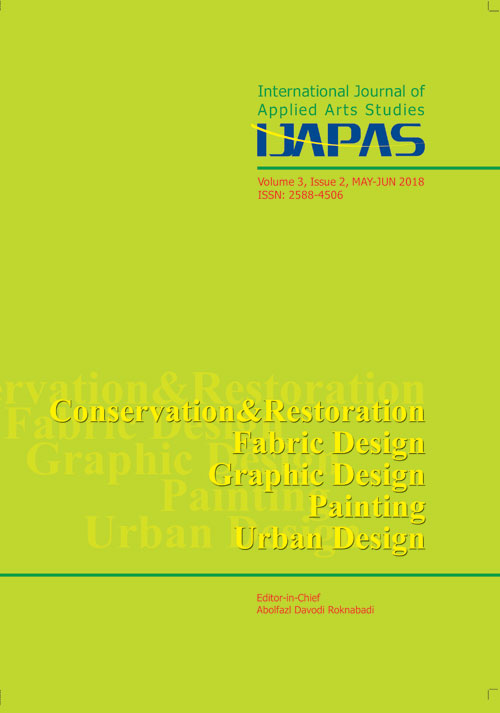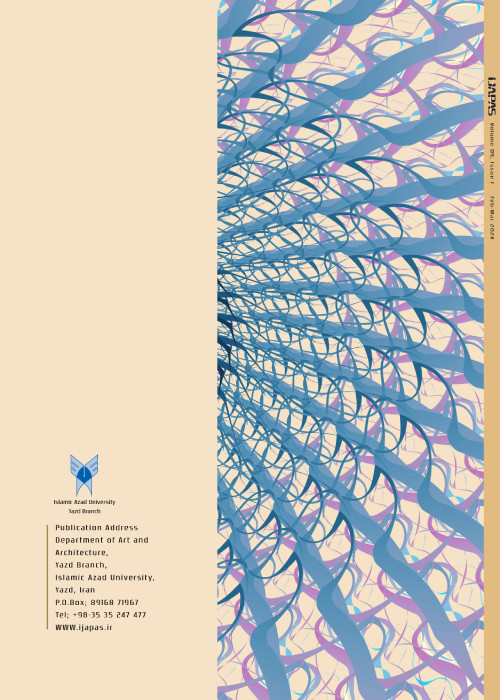فهرست مطالب

International Journal of Applied Arts Studies
Volume:3 Issue: 2, May-Jun 2018
- تاریخ انتشار: 1397/03/11
- تعداد عناوین: 6
-
Pages 7-15In history, games have always been there and companion of children and youth. Today, ancient traditional and education games have been forgotten and replaced by destructive computer games. Card games are among the traditional tools that can be used for educational purposes. This article seeks to introduce the process of producing and innovative product called CARTIN and answers to the question regarding the key characteristics of the graphic values of educational card games. The aim of this research is to present a suitable graphical approach for the development of the cards by considering the graphic fundamentals and standardization with respect to wide space and its popularity in the community. The study is practical and conducted with a descriptive-analytical method. The data collection is through library and field survey. The appearance, new design, innovative graphic and packaging materials are significant. Using warm, happy, lively, transparent and bright colors along with appropriate logotypes will be beneficial in organizational identity. Suitable size for the card has been 9 by 5.7 cm and 250 grams glossy cardboard material with a UV cover.Keywords: Graphic design values, Educational playing card, Graphic, CARTIN
-
Pages 17-28The Persian garden with a mansion and the water obtained from the qanat with the planting of flowers is in the form of a square or a rectangle. Examples of this type of garden are Dowlatabad garden in Yazd, which refers to the Zandieh period and Fathabad garden of Kerman, which was built during the Qajar period. The present study, using a descriptive-analytic method, investigated the architectural motifs of Dowlatabad garden of Yazd and Fathabad in Kerman. This study seeks to find the differences and similarities between the architectural motifs of these two complexes. The findings of the research show that geometric patterns are used as the basic and main drawings in the architecture of Dowlatabad Garden in Yazd. Geometric, plant, animal, human and such combination designs have also been used in the architecture of the Fathabad garden of Kerman. Geometric motifs are the common architectural designs in the two garden complexes.Keywords: Dowlatabad Garden, Fathabad Garden, Iranian Garden, Motifs, SPSS
-
Pages 29-40One of the characteristics of a building in Iran is the diversity in the type of land use and its architecture which has a direct relationship with thinking, creativity and people's need. Lubrication workshop structure is part of the native heritage that meets the needs of people in the environmental condition of that time. However, a few studies have been conducted on the mode of operation and spatial structure recognition. The aim of the present research is to identify the characteristics, principles of the formation of spatial species and extraction of efficient elements which have been selected as a case study of Najafabad mines (i.e. lubrication workshop). Therefore, the spatial structure of the lubrication workshop was analyzed and compared, based on library studies and field observations via a descriptive-analytical method. The physical factors were analyzed by the existing maps, and the spatial structure of the case sample was extracted. It was found that the lubrication workshop has distinct and recognizable patterns, and according to space and organization of the functional space it follows a single pattern. Further research can provide a background for architectural design that like the past is responsive to the needs of people and can be implemented as a model for resuscitation of native architectural identity.Keywords: Lubrication workshop, Physical, Najafabad, Native Architecture, Spatial Structure
-
Pages 41-50The lack of supplies and complimentary products of factories is one of the problems that are being considered in today’s world. The souvenir set designs for sewing machine factories can be a better approach for advertisement. Environmental protection is the duty of every human being. The earth is the home of humans and all individuals must be careful in environmental protection and spend their energy and income on green environment for the community. In this context, special promotions to develop a cultural background among people gains importance. In this paper, an attempt has been made to use a fabric base to design accessories and promotional gifts (or complimentary gifts) for sewing machine factories, which can both semantically relate to the factories’ final product and be environmentally suitable. Accordingly, after conducting the examination, the designs related to the concept of factory products (e.g. form of yarn or needle) were made with reference to the research objectives, and initial sketches were drawn and printed on the cotton fabric via silk printing technique. The results revealed an improvement of concept transferred to the audience along with advertising and efficiency related to factory products. The designs were consistent with factory products and efforts were made to preserve the environment.Keywords: Advertisement, Fabric, ComplimentaryGift
-
Pages 51-66So far, theoretical studies and little art reviews have been conducted on animal designs, and no such research has been done on Jiroft's civilization. The reason for choosing this civilization is its importance in pre-Iranian art, as well as the health and availability of the works of this civilization period. This study tried to study motifs, to recognize the origin and meaning of them, and to trace the cultural influences of their respective civilizations, and to analyze their symbolic aspects. The main question of this research is what kind of symbols and signs with the field of animal drawings are used in the works of Jiroft civilization, and what concepts and themes they represent. The purpose of this study is to achieve a more cognitive understanding of the symbolic aspects of animal designs of the works of Jiroft civilization. This study was conducted descriptively and analytically using library resources. In this study, ten of the works found in Jiroft civilization have been investigated and the results of this study show that in Jiroft containers, motifs represent a man of war with the hard nature of southeastern Iran. In these designs, the notion of duality, or dualism, and dual composition are very evident, which is a sign of dual similarities and an opposite duality. These two-dimensional repetitions with the same materials represent an emphasis on symbolic concepts such as power or importance to them.Keywords: Jiroft Civilization, Artifacts, AnimalDesign, Decorations, Symbolic Faces
-
Pages 67-74Culture and cultural values are a community, the identity and spirit of a city. Culture as a decisive factor in behavior is always in the realm of society, because it is shown in a set of beliefs, traditions, and behavioral patterns. Planning for the development of hiking culture is not an issue that will soon come to an end, but any decision taken in this matter will be tangible in the next 10 years. In this paper, the cultural criteria of the community have been studied. A questionnaire was used to collect the research data. The questionnaire items were based on the criteria of the cultural system. The research community in this research was 239,000 people. The sample size was selected randomly and using Cochran model 383 people were selected to complete the questionnaire. The SPSS software was used to study the relationship between society culture and the presence of citizens in pedestrian path. The results showed that there is a significant relationship between these two variables of culture and the presence of citizens.Keywords: CulturalValue, Pedestrian Path, Farrokhi Street


